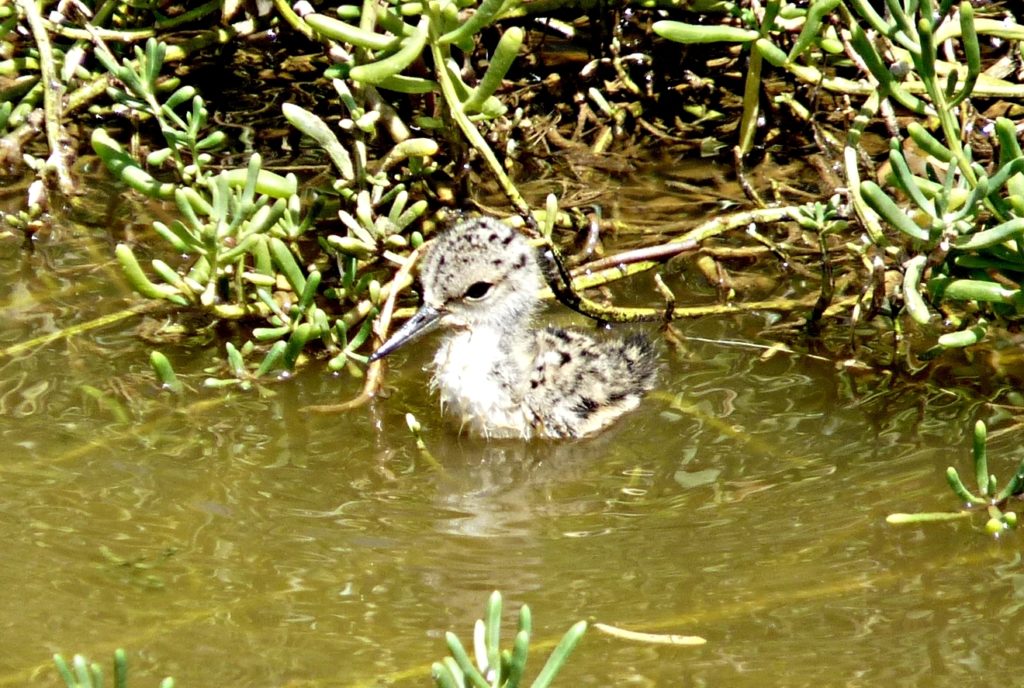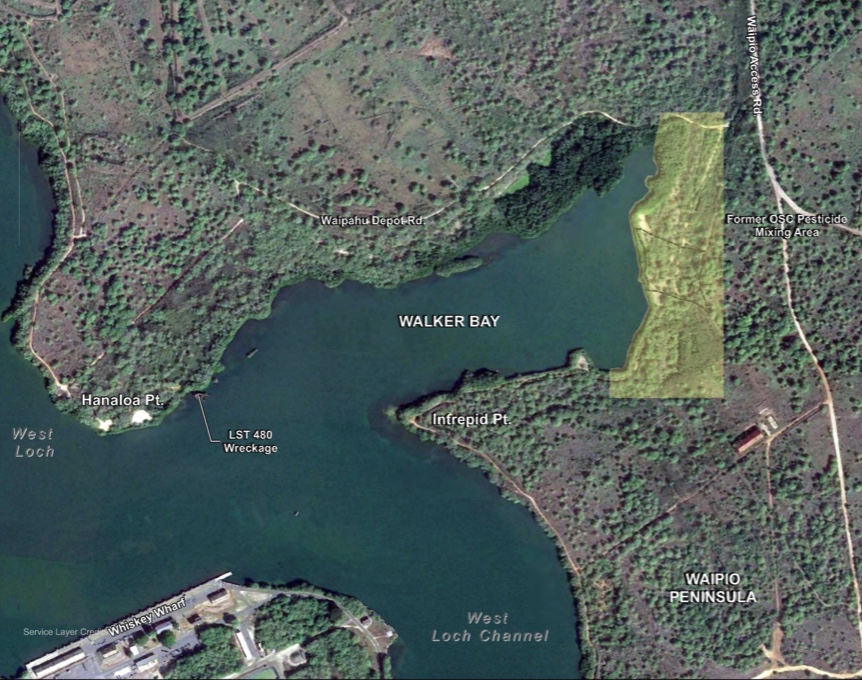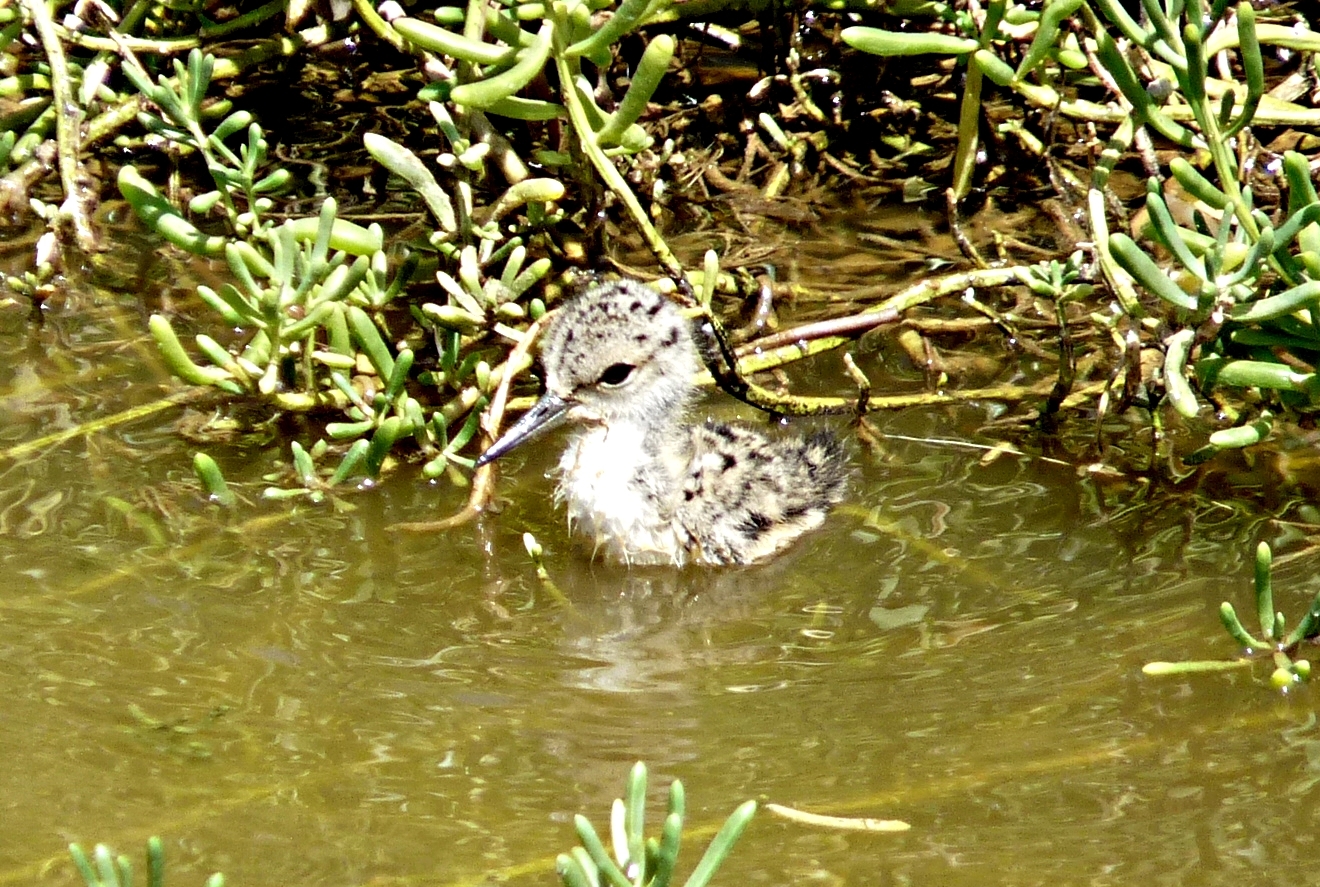
On April 19, the U.S. Navy, Environmental Protection Agency, National Oceanic and Atmospheric Administration, and Department of the Interior proposed settling a lawsuit they filed the same day against O‘ahu Sugar Company, LLC, and its successor, Ka‘anapali Land, LLC, over high levels of chemical contamination on at least 3.5 acres along the coast of the Waipi‘o Peninsula. The site, on the West Loch of Pearl Harbor, is where the former sugarcane company mixed and loaded pesticides, fertilizers, and herbicides for decades.
In a proposed consent decree signed by all parties to the case, the federal government would receive $5 million for the EPA’s and Navy’s response costs and $2.5 million for natural resource damages. The money is expected to come from the companies’ insurance proceeds.
Upon payment, the EPA would withdraw its 2005 and 2009 orders requiring the companies to do a site assessment and remediation.
In addition to providing the funds, the companies would withdraw their Freedom of Information Act (FOIA) requests seeking information clarifying their liability. (An attorney for O‘ahu Sugar long maintained that the Navy, O‘ahu Sugar’s lessor, held some liability for the contamination. The Navy argued that because of O‘ahu Sugar’s exclusive use of the area for so long, it had the primary responsibility to at least take interim measures to address any imminent dangers the site posed. In 2008, attorneys for Ka‘anapali Land sent letters to the Navy’s Office of the General Counsel expressing their disappointment with the Navy’s response to their FOIA queries regarding this site and others in the Pearl Harbor area.)
The public has until May 24 to comment on the proposed settlement. Comments may be emailed to pubcomment-ees.enrd@usdoj.gov.
High Risk
More than 20 years ago, the state Department of Health determined that the site, located at the edge of Walker Bay, was heavily contaminated and required immediate remediation.

O‘ahu Sugar went out of business around 1994, when sugar cultivation on the island ceased. The following year, the Navy assessed the suitability of the lands it had leased to the company since the 1940s for leasing in the future. A Navy consultant determined that O‘ahu Sugar’s pesticide mixing site was likely contaminated and should not be included in any lease.
In addition to pesticides, O‘ahu Sugar stored, mixed, and loaded herbicides and fertilizers at the site for use on its fields. Also on site were several above-ground storage tanks, a Quonset hut, and an air strip for its crop-dusting aircraft.
Soil sampling by the Health Department in 1997 found dioxin/furan contamination as high as 1,530 parts per billion (ppb) for 2,3,7,8-tetrachlorodibenzo-para-dioxin (2,3,7,8-TCDD) toxicity equivalents (TEQ). (According to the EPA, TEQ is “a method to describe total toxicity for dioxin congeners as if it were the most toxic dioxin, 2,3,7,8-TCDD.” 2,3,7,8-TCDD is the type of dioxin found in the defoliator Agent Orange.)
Dioxin is a toxin that can build up in food chains and is a known carcinogen. Under the Health Department’s 2010 dioxin soil action levels, 0.24 ppb would be considered safe for residential use, and 1.5 ppb would be safe under commercial or industrial land use.
Pentachlorophenol, a probable human carcinogen that can also cause damage to the liver and immune system, was found at levels between 8.4 and 35 parts per million, far exceeding the federal maximum contaminant level of 1 ppb. That limit is for drinking water, not soils per se, but pentachlorophenol can be absorbed through the skin.
“The cancer risk estimates greatly exceed the upperbound acceptable risk level of 1 x 10-4 indicating a potential for imminent and substantial health risks from exposure. A preliminary estimation of the excess cancer risk from
chronic exposure to dioxins in the soil at the site, assuming industrial land use, is 6×10-2(6 in one hundred or 60,000 in one million),” wrote Bryce Hataoka, acting manager for the Health Department’s Hazard Evaluation and Emergency Response (HEER) Office, in a January 9, 1998 letter to Melvin Waki of the Naval Facilities Engineering Command.
“With the serious threat posed by the dioxin contaminated soil at the former pesticide mixing area, the Department of Health is strongly recommending that the Navy, as the property owner, take immediate action to fully secure the dioxin contaminated area to prevent any human exposure to the highly toxic contaminant. The Department also recommends that warning/restriction signs be posted around the contaminated area to warn people of the hazard and keep them from entering,” Hataoka wrote.
On January 27, the department issued O‘ahu Sugar Company an administrative order requiring it to conduct a site assessment and respond appropriately.
The Navy quickly erected a 6-foot-tall chain link fence around the site and posted danger signs. O‘ahu Sugar then hired BEI Environmental Services to conduct a remedial investigation of the site.
BEI’s August 2002 report on its evaluation confirmed the Health Department’s soil sampling results showing extremely high levels of dioxin and pentachlorophenol contamination. Dioxin/furan levels neared 1,000 ppb in some samples of both surface and sub-surface soils. BEI also found pentachlorophenol at concentrations ranging from ranging from 12,000 ppb to 140,000 ppb, “above the 11,000 ppb EPA preliminary restoration goal,” the report stated.
Benzo(a)anthracene, Benzo(b)flouranthene, and Benzo(a)pyrene were also found in amounts that exceeded action levels. So were pesticides 4,4’-DDE, 4,4’- DDD, and 4,4’-DDT. At two sites, lead levels exceeded action levels.
Dioxins/furans were also detected in all three groundwater wells sampled. “Pentachlorophenol was detected at a concentration of 1,900 ppb, above the 13 ppb Hawai‘i State Contingency Plan regulatory level for saltwater in all three of the groundwater samples,” the report stated. 4,4’-DDT levels also far exceeded what’s allowed in the plan. (See sidebar in this issue.)
Falling Short
Neither the Health Department nor the Navy were satisfied with BEI’s work. Even before BEI started, O‘ahu Sugar’s attorney, Lisa Munger, and the Navy disagreed on the necessary scope of the investigation. Because the site fell within the Pearl Harbor Naval Complex Superfund site, the Navy felt the investigation needed to meet the requirements of the National Oil and Hazardous Substances Pollution Contingency Plan and the Comprehensive Environmental Response, Compensation, and Liability Act. Munger felt it was sufficient for the work to comply with just the state’s contingency plan.
Both the Navy and the Health Department stated in letters to O‘ahu Sugar that they believed BEI failed to adequately determine the extent of the contamination. BEI’s report suggests the dioxin contamination was limited to a little over an acre. Michael Miyasaka of the HEER office, however, argued in a March 2003 letter, “Our evaluation of the dioxin contamination levels … clearly points to a high probability that dioxin contaminated soil has migrated into Walker Bay. This situation will require an ecological risk assessment.”
The Navy added in its own letter, “The topography indicates that surface water may be picking up contaminants before it gets to the last monitoring well and carrying it to the bay. The monitoring wells closest to the bay may also be tidally influenced and resulting in a dilution effect.”
Even without knowing the full extent of the contamination, the EPA pressed both the Navy and O‘ahu Sugar to take action.
“Because the OSCO [O‘ahu Sugar Company] site is located adjacent to Pearl Harbor, surface runoff from this site presents a threat to the harbor ecosystem. Nevertheless, more than five years after the state of Hawai‘i order to clean up the site, the OSCO site is still contaminated and no action has been taken by either the Department of Defense, Department of Navy, or OSCO to abate the dangers posed by the contamination other than fencing and posting of the area,” wrote Keith Takata of the EPA’s Superfund Division in September 2003.
In an October 14, 2003, letter, Munger noted that her client, O‘ahu Sugar, “does not admit that its former facility poses an imminent and substantial endangerment to public health, welfare or the environment.” However, she said it would investigate possible interim response measures.
A month passed without anything further from the company, so on November 25, the EPA offered a work plan framework that included the placement of some kind of temporary cover on the site to prevent runoff and exposure of trespassers and the environment. Depending on the type of cover, the EPA estimated costs could range between $77,000 and about $1 million.
By then, investigators had seen bicycle tire tracks inside the chain link fence that the Navy erected to keep people out of the site, and there was evidence the fence had been cut and repaired more than once.
The Waipi‘o Peninsula Soccer Park lies less than 10 football fields away.
O‘ahu Sugar replied two months later. Rather than agreeing to implement any interim protective measures, it suggested that more site characterization work be done. In response to the EPA’s proposed work plan, the company had tasked BEI with preparing a plan for an interim remedy. However, it quickly became clear that the implementation costs would “substantially exceed the partial cost estimates provided by EPA’s contractor,” wrote O‘ahu Sugar vice president Tamara Edwards to the EPA’s Keith Takata in a January 23, 2004, letter.
“Given that conclusion, O‘ahu Sugar does not have the financial resources sufficient to conduct any of the alternative interim remedies [and] does not have the wherewithal to contribute meaningfully to the remediation of the site,” she continued.
A work plan for BEI was never finalized, but sediment samples taken as part of a separate study of Pearl Harbor found that the highest concentrations of DDTs and dioxin/furans in Walker Bay sediments were from shallow water near the O‘ahu Sugar facility, according to an EPA memo.
By August of 2004, the EPA felt it necessary to issue its own Administrative Order on Consent (AOC) to force O‘ahu Sugar to take some kind of mitigative actions. O‘ahu Sugar asked for more time to convince the Navy to be a party to the order. In response, the EPA withdrew its AOC and chose to issue a Unilateral Administrative Order. “Clearly, EPA’s concerns are best addressed by immediate cleanup activities rather than long drawn-out negotiations,” EPA assistant regional counsel Letitia Moore wrote Munger in an October 2004 letter.
The unilateral order, signed on March 28, 2005, required O‘ahu Sugar to determine the full extent of contamination and prevent exposure to soil contaminants “until a final cleanup remedy is implemented,” an EPA press release stated. Among other things, the company had to provide documentation that it had the financial ability to complete the work and had to submit monthly progress reports, prepare an acceptable Health and Safety Plan, and submit a final report upon completion.
Violations of the order or failures to comply could be subject to a penalty of up to $32,500 a day per instance.
The EPA recommended that O‘ahu Sugar place a geomembrane cover on the contaminated soil area, which would require the rerouting of a drainage ditch. The agency estimated the cover would cost $247,000 in addition to the cost of further site characterization, moving contaminated soil to fit under the cover, and monitoring.
Bankruptcy
Within days of the order’s signing, O‘ahu Sugar sent the EPA documents from the bankruptcy proceedings of its parent company, Amfac Hawai‘i, LLC, suggesting that O‘ahu Sugar did not have the financial ability to comply with the EPA’s order.
“The referenced claims against O‘ahu Sugar … were assigned to Ka‘anapali Land, LLC, pursuant to the terms of the bankruptcy plan that was approved by the bankruptcy court and totaled at least $160,000,000. As with any claims concerning Waipi‘o, O‘ahu Sugar is substantially without assets to satisfy the claims of Ka‘anapali Land, LLC, if a bankruptcy filing should occur as there are other remaining non-debtor [Amfac Hawai‘i] subsidiaries,” Munger wrote in an April 4, 2005 letter to the EPA.
The EPA was not convinced. In an April 11 reply from assistant regional counsel Larry Bradfish, the agency noted that Amfac Hawai‘i had merged with Northbrook Corporation in 1995, and that a financial statement for Northbrook stated that an insurance carrier for O‘ahu Sugar had agreed to defend the company in certain cases. What’s more, O‘ahu Sugar had since become a subsidiary of Ka‘anapali Land and Bradfish stated that the EPA would consider adding the latter company as a party to the order.
What happened after that is unclear, as the EPA’s online archive for the site does not include any documents after April 2005. It is clear from a correspondence log provided in response to a 2014 FOIA request that the EPA and attorneys for Ka‘anapali Land spent the next year or so debating the company’s liability with regard to the site.
Eventually, on January 27, 2008, the DOH issued an administrative order, attempting to again spur some responsive action. The EPA followed up with a unilateral administrative order in September 2009 requiring Ka‘anapali Land to complete an engineering evaluation and cost analysis for the site.
On October 30, Ka‘anapali Land’s attorneys John Hahn and Mayer Brown sent a letter to the EPA’s Bradfish stating that the company would conduct the work required by the state’s administrative order, but it still denied any liability and reserved its right to seek recovery of any costs expended.
The company hired ENVIRON International Corp. to conduct the site work and provide other deliverables of the unilateral order, including the health and safety plan.
ENVIRON began sampling in July 2011 and it appears that further sampling was recommended the following year.
Future Costs
To date, the site still has not been capped. ENVIRON attempted to delineate the extent of contamination. “However, the work was not completed for several reasons, including difficulty accessing the site due to its remote location and ‘blast zone’ restrictions, and the need for additional investigation,” the EPA’s Alejandro Diaz stated in an email.
He explained that the site is located within the Navy’s Explosive Safety Quantity Distance Arc, where construction is restricted.
He added that the Navy will “continue to investigate the site and determine what if any response actions may be appropriate in accordance with laws and regulations.”
Whether $7.5 million, the settlement amount, will be enough to cover costs remains to be seen.
Several years ago, the state Department of Hawaiian Home Lands completed the capping of another former O‘ahu Sugar pesticide mixing and loading site in East Kapolei, where the agency plans to build a residential subdivision.
The cost to install the geomembrane liner system covering the 0.6-acre site was nearly $1.7 million.
Because the state bought the site from Campbell Estate “as is,” O‘ahu Sugar paid nothing toward remediation costs. The liner system was mostly paid through DHHL’s trust fund. EPA brownfields grants and some state funding covered the rest.
The Waipi‘o site is more than six times as large as the East Kapolei site, is much more contaminated, and would seem to require more work, considering additional vegetation that would have to be cleared and the drainage ditch that would need rerouting.
When or whether Ka‘anapali Land’s insurer, Fireman’s Fund Insurance Company, will fork over the money may soon be decided. According to a November 2020 filing with the U.S. Securities and Exchange Commission for the quarter ending September 30, Ka‘anapali Land reported that it had sued the Fireman’s Fund in February 2015 in 1st Circuit Court “for declaratory judgment, bad faith and damages … in connection with costs and expenses it has incurred or may incur in connection with the Waipi‘o site.”
Ka‘anapali seeks “a declaratory judgment of its rights under various Fireman’s Fund policies and an order that Fireman’s Fund defend and indemnify Ka‘anapali Land from all past, present and future costs and expenses in connection with the site, including costs of investigation and defense incurred by Ka‘anapali and the professionals it has engaged. In addition, Ka‘anapali seeks general, special, and punitive damages, prejudgment and post judgment interest, and such other legal or equitable relief as the court deems just and proper.
“Fireman’s Fund has filed a responsive pleading. There are no assurances of the amounts of insurance proceeds that may or may not be ultimately recovered,” the filing states.
A trial has been delayed repeatedly over the years, most recently in October 2020. A trial was to have begun on February 8 and no new date has been set. A status conference was held on March 8, and another is scheduled for July 12.
— Teresa Dawson
For Further Reading
Our December 1991 issue reviewed contamination at the Navy’s Pearl Harbor Superfund sites:
- “Rare Birds Seek Refuge Near Toxic Wastes,”
- “Oil Contamination is Pervasive,”
- “Officers’ Club and School Among PCB Sites,”
- “The Navy’s ‘Superfund Six,’”
- “Editorial: Pearl Harbor Clean-up is a Fitting Tribute,” and
- “In Memory of Pearl Harbor: The Losses Gone Unsung.”
For more on contamination at O‘ahu Sugar’s East Kapolei site, see the following stories in our July 2001 issue:
- “$31 Million Purchase Price Only Start of State Expenses for O‘ahu Sugar Land,”
- “Exceeding the Limit,” and
- “Editorial: ‘Ewa’s Golden Triangle: Fool’s Gold for the State.” Also see, “DHHL Edges Closer to Cleanup of Contaminated Soils in ‘Ewa,” from our September 2010 issue.All and more are available for free at environment-hawaii.org.


Leave a Reply